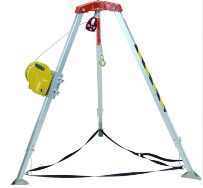




Most people's understanding of the application scenarios of rescue tripods is limited to ordinary rescue environments and low spaces. Many people know that the legs of rescue tripods can be adjusted in multiple sections to reduce their overall height, in order to allow the rescue tripod to smoothly enter some low spaces for installation. However, this is not the only special rescue scenario of rescue tripods.

The adjustable function of the support legs of the rescue tripod gives it some flexibility, but most people use this function to raise and lower the three support legs at the same height, in order to adjust the overall height. However, in addition to this application method, it is also possible to adjust the lifting and lowering of different heights, that is, to make one of the support legs longer and one of the support legs shorter. The purpose of this adjustment is to make the rescue tripod form a different inclination.
The adjustment of the unequal height of the three legs of the rescue tripod can cause its support to tilt, which is precisely designed to cope with some non flat terrain environments. Supporting in such environments can help it find balance as a whole, thus maintaining balance and stability like on flat ground, ensuring the safe and smooth progress of rescue work. We can regard it as a hidden function of the rescue tripod, which makes its application scenarios more extensive.